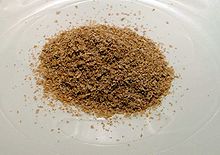Bran
This article needs additional citations for verification. (August 2018) |

Bran, also known as miller's bran, is the hard layers of
Bran is present in cereal grain, including rice, corn (maize), wheat, oats, barley, rye, and millet. Bran is not the same as chaff, which is a coarser, scaly material surrounding the grain, but does not form part of the grain itself, and which is indigestible by humans.[2]
Composition
Bran is particularly rich in
The high oil content of bran makes it subject to rancidification, one of the reasons that it is often separated from the grain before storage or further processing. Bran is often heat-treated to increase its shelf life.
| Nutrients (%) | Wheat | Rye | Oat | Rice | Barley |
|---|---|---|---|---|---|
| Carbohydrates (excluding starch) | 45–50 | 50–70 | 16–34 | 18–23 | 70–80 |
| Starch | 13–18 | 12–15 | 18–45 | 18–30 | 8–11 |
| Proteins | 15–18 | 8–9 | 13–20 | 15–18 | 11–15 |
| Fats | 4–5 | 4–5 | 6–11 | 18–23 | 1–2 |
Rice bran
Rice bran is a byproduct of the
Uses



Bran is often used to enrich
Rice bran is stuck to the surface of commercial ice blocks to prevent them from melting.[citation needed] Bran oil may be also extracted for use by itself for industrial purposes (such as in the paint industry), or as a cooking oil, such as rice bran oil.
Wheat bran is useful as feed for poultry and other livestock, as part of a balanced ration with other inputs. Wheatings, a milling byproduct comprising mostly bran with some pieces of endosperm also left over, are included in this category.
Bran was found to be the most successful slug deterrent by BBC's TV programme
Research
As with cereal fiber and whole grain consumption, bran is under preliminary research for the potential to improve nutrition and affect chronic diseases.[5][6]
Stability
Commonly, bran is heat-treated with the intention of slowing undesirable rancidification, but a 2003 study of heat-treatment of oat bran found a complex pattern whereby increasingly intense heat treatment reduced the development of hydrolytic rancidity and bitterness with time, but increased oxidative rancidity. The authors recommended that heat treatment should be sufficient to achieve selective lipase inactivation, but not so much as to render the polar lipids oxidizable upon prolonged storage.[7]
See also
- Alkylresorcinols
- Cereal germ
- Phytic acid (IP6)
- Rice bran solubles
- Raisin bran
References
- ^ Corn Chemistry and Technology Watson and Ramstad 1987 p. 69
- ISBN 978-94-009-0445-3. "chaff, which is indigestible for humans"
- ^ "Inorganic Arsenic in Rice Bran and Its Products Are an Order of Magnitude Higher than in Bulk Grain". Environmental Science & Technology. Pubs.acs.org. 21 August 2008. Retrieved 9 February 2010.
- ISBN 978-0262180306.
- S2CID 73449809.)
{{cite journal}}: CS1 maint: multiple names: authors list (link - doi:10.1017/S0029665120004802.)
{{cite journal}}: CS1 maint: multiple names: authors list (link - ISSN 0733-5210. See figure 1 in particular


